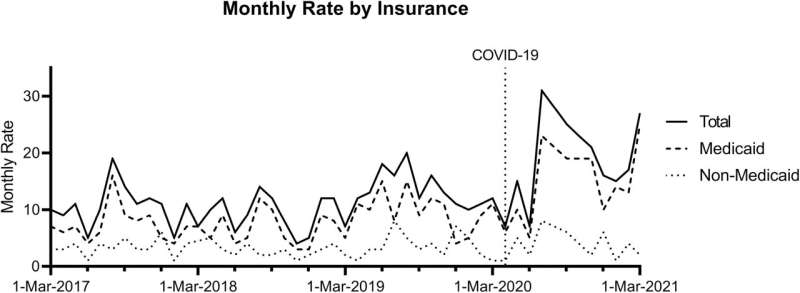Rise in new-onset type 2 diabetes among Alabama youth during COVID-19 pandemic

Alabama, a state with many counties in the United States Diabetes Belt, saw an increase in new-onset type 2 diabetes among youth during the COVID-19 pandemic. Results published in the Journal of Clinical Endocrinology & Metabolism showed the significant increase and indicated that Medicaid enrollees and males were disproportionately affected by the disease.
Researchers at the University of Alabama at Birmingham conducted the retrospective study using data from Children's of Alabama to look at new type 2 diabetes cases from March 2017 to March 2021. Prior to the start of the pandemic, the average monthly rate of new pediatric diagnoses was 11.1 new cases. After April 2020, the monthly rate increased to 19.3 new cases.
"Existing studies already showed a worrisome increase in pediatric type 2 diabetes, specifically among low-income and ethnic minorities," said Ambika Ashraf, M.D., director of the Division of Pediatric Endocrinology and Diabetes at the UAB Marnix E. Heersink School of Medicine and Children's and associate director of the Comprehensive Diabetes Center. "Our results suggest the COVID-19 pandemic further exacerbated the concerning trend."
Pediatric type 2 diabetes, often referred to as a "disease of poverty," occurs when one's body does not produce enough insulin to properly regulate blood sugar levels. The long-term condition can lead to an increased risk of disorders in the nervous, immune and circulatory systems. Other risk factors for type 2 diabetes include weight, inactivity, family history, age, prediabetes, race and ethnicity.
"Approximately 53% of all children in Alabama are enrolled in Medicaid, which is often an indicator of lower family income," said Jessica Schmitt, M.D., first author and assistant professor in the Division of Pediatric Endocrinology and Diabetes at UAB and Children's. "In addition to medications, maintaining a healthy diet and activity level are important in management of type 2 diabetes. This can be difficult for children living in lower socioeconomic conditions.
While the UAB team discovered the startling increase in new-onset type 2 diabetes pediatric cases, in both Medicaid- and non-Medicaid-enrolled youth, Ashraf says further studies are needed to determine the exact cause of the increase.
"There was a drastic change in activity and sedentary lifestyles in youth during spring of 2020, and other studies show that adolescent males experienced greater weight gain and were more sedentary than female counterparts," Ashraf said. "However, we do not know if these short-term changes are directly linked to the increase in diagnoses. We also did not have information on prior COVID-19 infections among patients studied."
More information: Jessica A Schmitt et al, Changes in Type 2 Diabetes Trends in Children and Adolescents During the COVID-19 Pandemic, The Journal of Clinical Endocrinology & Metabolism (2022). DOI: 10.1210/clinem/dgac209




















